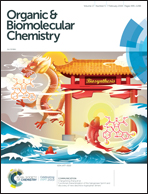New flavonoids from the Saudi Arabian plant Retama raetam which stimulates secretion of insulin and inhibits α-glucosidase†
Abstract
Retama raetam is a bush which is a member of the family Fabaceae. It is used traditionally in North Africa and Saudi Arabia for the treatment of diabetes. Several flavonoids and alkaloids are already known from this plant. Chromatographic fractionation and purification led to the isolation of three new derivatives of prenylated flavones, retamasin C–E, and four new derivatives of prenylated isoflavones, retamasin F–I, in addition to two isoflavones which have not been previously reported in this plant. Particularly interesting structures included isoflavones containing 3,5-dihydro-2H-2,5-methanobenzo[e][1,4]dioxepine and 3a,8b-dihydro-7-hydroxyfuro[3,2-b]benzo[2,1-d]furan units, both of which are new amongst natural product flavonoids. Five new examples (two flavones and three isoflavones) strongly enhanced the glucose-triggered release of insulin by murine pancreatic islets and one isoflavone was a potent inhibitor of α-glucosidase. This study may rationalise the traditional medicinal use of R. raetam and provide new leads for drug design in the treatment of diabetes.



 Please wait while we load your content...
Please wait while we load your content...